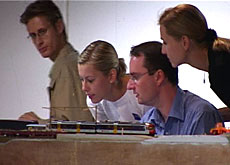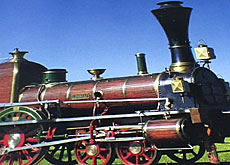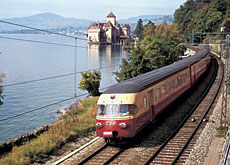Exhibition provides platform for railway buffs

There’s much more to Swiss railways than just carriages, stations and tracks - a new exhibition shows that they are an integral part of the country’s history, culture and national identity.
But the main focus of the Rail 03 exhibition at the Transport Museum in Lucerne is on those who collect and restore railway artefacts.
“Visitors can touch the railways, play with them, put them together, and even help to restore them,” exhibition director Kilian Elsasser told swissinfo.
Hidden treasures
This is a chance for enthusiasts to show off their priceless collections, many of which have remained hidden for decades.
Antique model trains glint behind shiny glass cabinets.
There’s a huge array of accessories such as old train lamps, railway telephones, stationmasters’ caps and train tickets through the ages, and videos beside each display show how the artefacts were amassed.
The collectors are all personal acquaintances of exhibition director, Kilian Elsasser, and it has taken him years to persuade them to share their treasures with a wider public.
The Swiss Association for Railway Amateurs dominates half of one display hall, with working model railways representing different periods in train history.
In another part of the spacious exhibition, restoration experts demonstrate the attention to detail needed to properly restore an old railway carriage.
“It can take volunteers several years, working every spare moment they have, to restore a wagon like this,” Elsasser explained.
Driving Practice
There’s also a fun side to Rail 03, such as the simulators teaching visitors train driving skills.
Instructors explain how to work the controls of the Trans European Express from the sixties. This was the first train able to run on all of central Europe’s electrical networks. (see related item.)
Or you can try your hand at driving modern high-speed trains. Fortunately, the automatic brakes kick in if the driver exceeds 140 kmph on the simulated track.
Younger visitors are free to build their own trains out of robust polymer blocks and watch them chugging around a track through idyllic plastic countryside. There’s also a miniature steam train outside, providing pleasure trips for little people.
Nearby, army engineers demonstrate their skills in building tracks, and transporting goods by using just hand power. It’s a high priority to be able to secure supplies in times of emergency.
Blast from the past
The Federal Railways Heritage Foundation (SBB Historic) has its own section, displaying films and photographs charting the development of the Swiss railways.
The introduction of steam trains opened the alpine country to the world in many ways, facilitating travel and transport of goods.
Thanks to the train timetable, times were standardized throughout Switzerland. The development of the telegraph – the nerve centre of the railways – was a major breakthrough for communications in general.
Engineering factories proliferated, providing increasingly sophisticated equipment for the railways.
There were also benefits for business. Up until the middle of the 19th century, joint stock companies hardly existed and had to be approved by special laws passed in individual states.
Due to the enormous investment needed for the Swiss railways, joint stock companies became the norm here.
Changing times
The development of the railway network dominated the political agenda of the fledgling federal government.
Parliament initially decided that construction should be carried out privately, with individual cantons participating. But building problems threw some cantons into political and financial chaos.
The government had to overcome political resistance before it could buy back the railways from the cantons in the 1880s and 90s, and set up Swiss Federal Railways.
As the needs of rail users changed, so did railway stations. The exhibition features a state of the art, graffiti-proof station, and gives details of Federal Railways’ extensive modernisation programme.
More than 600 smaller and middle-sized railway stations are due to be refurbished in the coming years.
The exhibition runs until October 19.
swissinfo, Julie Hunt in Lucerne
Collectors open up their long-hidden treasure chests of antique train artefacts.
There’s a restoration workshop, where visitors can see what it takes to refurbish an antique train carriage.
In a “tunnel cinema”, films show the development of the Swiss train network, and what it’s like to be a railway worker.
You can step on board and take a look inside many different types of trains.
Dinner is served on board a stationary rail carriage.
The Rail 03 exhibition at Lucerne’s Transport Museum showcases some of the most extensive private collections of rail artefacts ever displayed in Switzerland, as well as providing a fascinating insight into how the development of the rail network went hand in hand with industrialisation.

In compliance with the JTI standards
More: SWI swissinfo.ch certified by the Journalism Trust Initiative



You can find an overview of ongoing debates with our journalists here. Please join us!
If you want to start a conversation about a topic raised in this article or want to report factual errors, email us at english@swissinfo.ch.